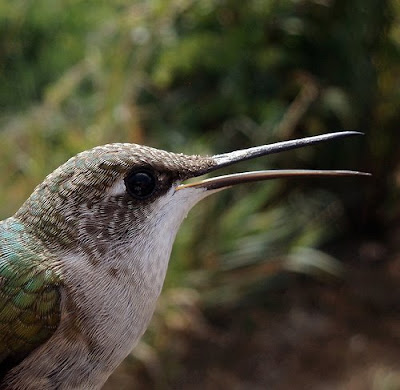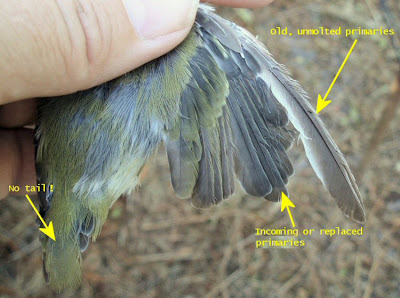
The other day I banded this HY (hatching-year) cardinal with a bill tumor. It looks sort of like a scab or blob of gunk stuck on the bill, but it's actually growing out of the tissue near the base of the bill. The dark coloration of the rest of the bill is normal: young cardinals have dusky-colored bills well into fall. It's one of the easiest ways to tell a juvenile from an adult.
Bill tumors and other deformities are not terribly uncommon. They often are seen on young birds, probably because many of the deformities ultimately impact survival. Most tumors I have seen have been due to a virus called avian pox. As I wrote on the RRBO bill tumor page, avian pox most frequently causes lesions on the feet and legs of birds, but also affects other soft parts. Pox lesions are scabby, crusty, or warty growths. If near the nostril they can obstruct breathing, or can obstruct vision if near the eyes. The lesions fall off after about a month when the virus runs its course, but it appears they can sometimes compromise the bill structure -- some post-pox birds have chunks of bill missing. This may not be due to the pox itself, but might be due to secondary infections of the pox lesions. Pox can be spread by mosquitoes, or contact between birds (thus it can be spread at feeding stations).
The tumor on the cardinal does not appear to be due to pox, as it actually seems to be growing out of the horny structure of the bill versus "on top," which is how pox often presents. I don't think this tumor is life-threatening in any way, if it doesn't continue to grow. The inside of the bill and mouth are okay, it doesn't look like it will interfere with feeding or grooming, and the nostril is open.
Bill deformities such as crossed bills are a whole other matter. Many years ago, upon capturing a catbird with a crossed bill, I did some research, and ended up publishing a paper on the incidence of bill deformities in passerine birds (songbirds) in North American Bird Bander. Since then, I have kept a compilation of these kinds of deformities in songbirds on the RRBO web site. Many have been contributions from banders and people who have seen the information on the site (I moderate a group on the photo sharing site Flickr on bill deformities which includes all types of birds, not just songbirds).
It is hard to say whether these types of deformities are increasing, or if awareness is just elevated. However, there is one geographic region where something is definitely going on: the Pacific Northwest and in particular Alaska. The USGS's Alaska Science Center has devoted a section of their web site to these abnormalities, many showing up in chickadees.
The USGS Alaskan researcher, Colleen Handel, cited my paper and the RRBO web site several times in her presentation on "The mystery of the long-beak syndrome" at a recent ornithological conference. Colleen and I have discussed these deformities several times over the years, and are planning on collaborating on a paper next year.




















